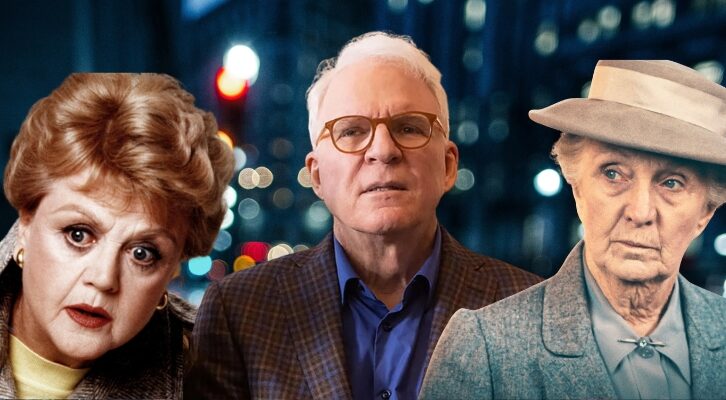
How Literary Ghosts Can Help Us All Be a Little More Human
Amy Shearn on Novels by Toni Morrison, Hari Kunzru, George Saunders and More
Let’s start by assuming that ghosts are real, probably, maybe, in some way. I’m no parapsychologist but come on, how could it actually be that a human being—those magnificently complicated bodies and brains, each an entire universe unto itself—could one day exist and the next day cease? Even if you have never had an intimate experience with a ghost (perhaps falling in love with one!), surely you’ve had the experience, at some point (Ouija board? A vivid dream of Grandma?) of feeling a spectral presence, sensing someone lingering between realms.
Or, okay, at the very least, we can all agree that hauntings are a very useful metaphor. “Whether or not ghosts are real,” writes Erica Wright, “their stories give us inspiration, a way to live more alert to possibilities.” A ghost in a story can deliver information living characters lack access to, so it’s no wonder spirits have apparated throughout Western literature, from Hamlet’s truth-telling father to the psychological spirits of Henry James’s The Turn of the Screw. A literary ghost can also be a neat way to link a story’s present with the past, a seductive trick for the expansively-minded novelist. The contemporary American ghost tends to be a little more complicated, however, than a Dickensian Ghost of Christmas Past rattling around in a nightgown. As Parul Sehgal writes in the New York Times, “The ghost story shape-shifts because ghosts themselves are so protean—they emanate from specific cultural fears and fantasies… They are social critiques camouflaged with cobwebs; the past clamoring for redress.” She notes that America is a haunted country, despite, or maybe because of, our “energetic amnesia.”
I thought about this a lot when writing my novel Unseen City, which is about, essentially, how New York City is one big haunted house—particularly, how the spaces in which we live, from rented rooms to teeming cities, hold the imprint of those that came before. The events of this year (this decade, this century) have underlined the fact that America itself is a country haunted by ambiguous grief and unresolved trauma. And just as houses are literally shaped by the habits and treads and movements of the people that live in them, our selves are molded into shape, in part, by that which we have lost.
The American literary ghosts I love most aren’t psychological shadows—they are solid enough to slam doors. But they’re not horror movie monsters either. They’re conflicted beings with messages more complicated than the expected “avenge me” spiel; they want us to think about what it means to be a human in the world.
*

Toni Morrison, Beloved
(Vintage)
Beloved is famously a ghost with physical heft, haunting a house from page one: “124 was spiteful. Full of a baby’s venom.” Sethe, a formerly enslaved woman, long ago killed her baby rather than letting her become enslaved. The child was buried with a tombstone reading only “Beloved.” That her ghost haunts Sethe’s house is common knowledge in their community. And when Beloved arrives—“A fully dressed woman walked out of the water” —there’s very little doubt that the baby has been reborn. Beloved is supernaturally thirsty, exhausted, barely speaks—taking on human form after 18 years in between realms is, one can imagine, hard work.
Beloved’s arrival coincides with the return of Paul D, a man from the plantation Sethe escaped from, who (not unlike Beloved) seems like an embodiment of sensuousness, a symbol of the body trying to return to itself. He and Sethe start a—not a romance exactly, but a sexual partnership. When he sees the scars on Sethe’s back, the legacy of her time at the nightmarish plantation, “he would tolerate no peace until he had touched every ridge and leaf of it with his mouth, none of which Sethe could feel because her back skin had been dead for years. What she knew was that the responsibility for her breasts, at last, was in somebody else’s hands.” The house begins to lurch, and presumably, like the jealous toddler she in many ways still is, Beloved is summoned. But when Beloved shows up in the flesh, Paul D is drawn to her sexually, too –and soon pain and pleasure layer like sediment; life and death and rebirth jangle together in the increasingly crowded house.
The pleasures of the flesh, the sheer human joy of being alive in a body, are hard won experiences for these characters. There’s a sharp contrast with Beloved’s uneasy habitation in her largely hypothetical body, which starts after a while to dismantle. At one point she casually pulls out a tooth, thinking, “Pieces of her would drop maybe one at a time, maybe all at once.”
As Seghal writes, our country is haunted by the “foundational crimes of chattel slavery and genocide.” Beloved asks us—forces us—to think about the unescapable epigenetic trauma of slavery. It also demands: How can a person (Beloved, Sethe) sometimes be alive and dead at the same time? What is a body? What is it for? To whom does a person’s body belong? And—a chillingly relevant question, this violent and plague-stained summer—who does our country ask to sacrifice their bodies, and for what?

Siobhan Adcock, The Barter
(Plume Books)
Here is another haunted mother. It doesn’t surprise me, really, that so many great ghost stories focus on mothers. There’s something about giving birth that sets a person uniquely in between the realms of life and death.
In The Barter, Bridget is a new mother who starts to suspect her house is haunted. “Later, when she is at her most terrified, she’ll wonder whether she brought the ghost into her house somehow just by thinking about death so habitually, so unwisely,” writes Adcock. Bridget is home with her baby, often trapped inside by the Texas heat. Like so many middle-class American mothers, Bridget was trained for another life altogether—she was an attorney and unsurprisingly, finds being a suburban stay-at-home mom to be somewhat understimulating—and now finds herself alienated from her clueless husband, and simultaneously overwhelmed by the awesome responsibility of caring for a new life and laid low by the sheer boredom of most of her actual daily tasks. She’s very alone—most days it’s just her, her baby, and the ghost.
This ghost is legitimately terrifying—shifting and grotesque, visible only to Bridget and her baby daughter—and like Beloved, carries with her the uncanny rankness of the buried: the scent of wet earth is one of the signs that she’s near. Bridget senses the ghost in the house all day long, and from the beginning she knows the ghost, as they often do, wants something from her.
The ghost does indeed want something from her; Rebecca was a young bride in the early 1900s when she lived where Bridget’s house is, part of the German immigrant community that farmed that part of Texas. Rebecca’s mother died giving birth to her, leaving Rebecca terrified of motherhood. Rebecca’s own marriage is a largely loveless catastrophe, but she does survive the birth of her son. When this beloved only child falls ill, Rebecca is faced with a supernatural iteration of the choice all mothers (remember Sethe?) simultaneously fear and already know the answer to: what would you trade to preserve your child’s life? Rebecca’s ghost is scary, but she’s also just a mother looking for a second chance, and possibly even hoping to guide Bridget out of the dark place that early motherhood can be. Bridget is struggling and Rebecca sees someone about to repeat her own mistakes. Her guidance isn’t subtle (ghosts are as emotionally bare as children, don’t you find that?), but Rebecca knows something real and elemental about motherhood: that it’s a shadowy, liminal place between life and death, and that new mothers need all the help they can get.
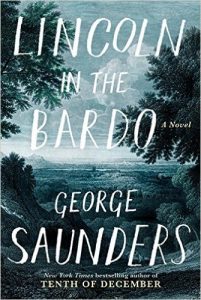
George Saunders, Lincoln in the Bardo
(Random House Trade)
Another grieving parent, this one Abraham Lincoln, plumbs the depths of grief in Saunders’ form-busting novel. Like in Beloved, the foundational trauma of America plays a role in the hauntings here—the book takes place in 1862, just a year into the Civil War. This book layers the voices of hundreds of ghosts stuck in the Bardo, or a kind of purgatory; often the ghosts deny that they are dead at all. The ghosts are shocked by the arrival of Willie Lincoln, the president’s 11-year old son. (I do think this is an optimal age for a ghost—it happens to be the age of my book’s ghost. Something about that moment just before puberty seems to be very much like birth, or death—such a vast transformation awaits, that bridge between worlds.) Children, the ghosts note, don’t often linger long in the Bardo.
But Willie is compelled to stay because his father keeps visiting—a convention-breaking occurrence that shocks/dismays/delights the Bardo community—to hold Willie’s body in its crypt. Willie responds by re-entering his body (“the worm,” he calls it) so that he can interact with his father; “In there, held so tight, I was now partly also in Father / And could know exactly what he was.” In a way it’s the fantasy of every grieving person—that if you just keep loving the person who has died hard enough, they will, in whatever realm they float, be able to hear it, and know it, and send you some message back.
Throughout the book, angels take on various forms and attempt to coax these lost souls along into the next realm. “You are a wave that has crashed upon the shore,” they say. But these stubborn ghosts aren’t ready, for reasons as varied as humans are—some petty, some profound. The ghosts take on various forms in ways that, truly, delightful to read, from Bevins with his multiplicity of eyes and noses and hands (“little bit scary,” Willie reflects) to those who have lingered too long and lost track of their human forms nearly altogether, like Mr. Papers—“essentially a cringing gray supine line.” How we hang on to our bodies once we’re meant to let them go, in this realm, seems to reveal something crucial about how we lived our lives.
But in the end, these ghosts—like all ghosts, I suppose—have to make some decisions. They have to choose to move on to the next realm, rather than linger in the meadows of Bardo for eternity, losing their form like slowly dissolving soap bubbles. The same is true of their mourners. Poor President Lincoln has to let Willie go in order to do his own life’s work—which, of course, would involve leading the nation through a period of unimaginable loss and grief.
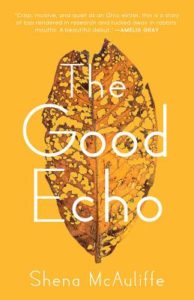
Shena McAuliffe, The Good Echo
(Black Lawrence Press)
Maybe so many ghost stories are about dead children because their deaths are premature, their lives forever unresolved. Another dead boy on the cusp of his teen years takes center stage in The Good Echo. “I died of sepsis from an infected root canal. My father was my dentist,” Benjamin begins, going on to narrate the story of his parents and what happened to them leading up to, and after, his death. “Death has made a storyteller of me,” he says. What follows is, among other things, a fascinating profusion of information about early dentistry, along with a clear-eyed look at a troubled marriage.
Like Beloved and Lincoln in the Bardo, and maybe even The Barter too, The Good Earth dives into the sticky morass of parental guilt. (A universal enough topic: After all, since parents bring their children into the world, every child’s death is his parents’ fault in a way.) After Ben’s death, his father embarks on a mission to travel the world studying dental care and nutrition, testing out his sometimes controversial theories (to occasionally disastrous effect). Again we have a story of bodies and the way they fail us. The child’s dental surgery kills him, and his father becomes more and more obsessed with trying to solve the mysteries of how teeth and nutrition and spirits and bodies are all interconnected.
But interestingly, this ghost doesn’t haunt. He doesn’t interact with his parents, just observes them, translates them for us, and, movingly, understands them in a way children don’t generally ever have a chance to. McAuliffe has said of writing this book from the ghost’s point of view: “He’s a child-ghost, and some of the sections that he narrates are very much spoken from a child’s sensibility, but being dead also provides him with a sort of omniscient vision of the world, of the past and the future.”
Being human is mysterious work, isn’t it? We love to pretend that’s only what can be seen, can be real. Our teeth, our bodies, the work we leave behind (as in the case of Ben’s legacy-obsessed father). But sometimes they seem like the least “real” part of us.
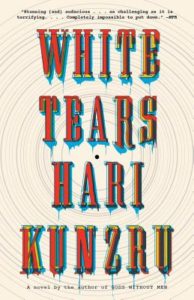
Hari Kunzru, White Tears
(Vintage)
The ghostly presence in White Tears is a perfect example of Seghal’s theory that today’s literary ghosts “emanate from specific cultural fears and fantasies.” In this book, white hipsters obsessed with Black blues musicians engage in a form of cultural appropriation so problematic that they awaken the dead. Pretty bad, right? Seth and Carter have opened a recording studio, bankrolled by Carter’sfamilial wealth. One day Seth is recording a city soundscape, and when he plays it back he discovers a ghostly old blues song. They post the song, which they claim is a rediscovered recording by a singer named Charlie Shaw.
But it turns out there really was a blues singer named Charlie Shaw, and Seth and Carter have awakened an angry, and often terrifying, spirit. Where did the song come from? Was the ghost there all along? Seth hypothesizes that “sound waves never completely die away, that they persist, fainter and fainter, masked by the day-to-day noise of the world.”Something I think is so interesting in this book is the way the spirit operates, with the heat and energy of entire generations that are sick and tired of being exploited; it makes sense when you think about how (echoes of Beloved) the blues is music born of slavery, the stolen song itself an echo our country’s foundational evil. (Interesting that the author, who now lives in Brooklyn, is originally British-Indian—perhaps in possession of some distance that helps him observe American culture with extreme clarity.)
He’s a violent one, as ghosts go, completely dismantling even the narrative of the book once he takes over, unsettling and dislocating the characters and readers alike—and who can blame him? As one Black character says in the novel, “we’re fascinating to you, long as we’re safely dead.” Living in New York City, I’ve often thought that gentrification is itself a kind of ghost story—wealthy white people plowing into other peoples’ homes, armored with an intoxicating combination of manifest destiny and privilege, nodding towards a place’s history when it suits, otherwise ignoring. In White Tears, the reader is asked to think about music, too, and art more broadly, about what stories belong to whom.
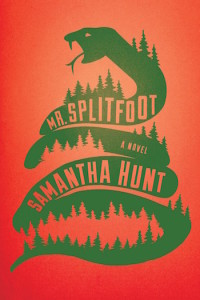
Samantha Hunt, Mr. Splitfoot
(Mariner Books)
After all, memory has muscle, and the energy of the dead (like the sound waves Seth wonders about) doesn’t really go anywhere—that’s what all these stories end up being about. I hope I’m not spoiling anything by including Mr. Splitfoot on this list, because there is (spoiler alert!) a character you don’t realize is a ghost—or I didn’t anyway—until the bitter end. But even before that delicious Sixth Sense-ish reveal, this is a ghostly story, infused with a submerged sense of the uncanny in a Shirley Jackson-esque way. As Samantha Hunt has said: “Hauntings are residues, things that are left behind. Or, they are things that hide themselves well. Until they don’t. Then, Boo!”
This book, like The Barter, intertwines two storylines together. In one of them, a (reluctantly) pregnant young woman named Cora is taken on a strange and seemingly endless walking voyage by her mute Aunt Ruth. Like Bridget, Cora becomes aware that motherhood will change, is changing, her relationship with death and life and human bodies. “Motherhood makes you a dealer in death,” someone tells her along the way. “No one tells you this beforehand.” Oh, Cora knows—and for that matter, Ruth knows.
The other storyline excavates Ruth’s childhood, when she lived in a rather cult-like foster home, and performed séances with her friend Nat for money. She doesn’t really think she’s able to speak to ghosts (though Nat might be), but she’s interested in the mourners who come to her, desperate to connect with their dead. It’s seductive, the idea that the dead miss their living, too, enough to (like Lincoln, like Ben) visit in any way they are able. When Nat tries to channel Ruth’s own dead mother, he instead reaches someone named Mr. Splitfoot. “For her, Mr. Splitfoot is a two that is sometimes a one, mothers and their children, Nat and Ruth, life and death.”
Life and death. Past and present. Fitting that we end here, with Hunt’s characters’ journey to Upstate New York, famously the home of spiritualists who have long claimed to be able to communicate with the dead. What is a novel, really, if not an attempt to communicate across the void, to connect the inanimate with the animate, the quick and the dead? I think this is particularly true of the American novel, as we struggle to process the history that we’re so mired in and so avoidant of, all at the same time.
And then, of course writers and readers are fascinated with death, and what’s left behind. It’s a fascination that’s about as universal as they come. Here we are, in our fallible human bodies, wanting pleasure, feeling pain, wondering where our dead have wandered off to, wondering what it will be like for us. “In the end, all of us will be stripped bare. Teeth scattered in a garden,” McAuliffe writes. “Here is Death, raining stars upon you.”
__________________________________
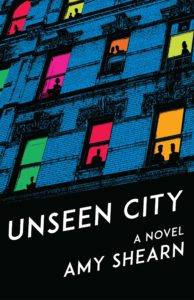
Unseen City by Amy Shearn is available September 29th from Red Hen Press.
Amy Shearn
Amy Shearn is the award-winning author of the critically-acclaimed novels Dear Edna Sloane, Unseen City, The Mermaid of Brooklyn, and How Far Is the Ocean from Here. She has worked as an editor for Medium, JSTOR, and Condé Nast, among other organizations, and her work has appeared in the New York Times, “Modern Love” column, Slate, Real Simple, Martha Stewart Living, O, The Oprah Magazine, Poets & Writers Magazine, Literary Hub, The Millions, The Rumpus, and other publications. Amy Shearn has an MFA from the University of Minnesota, and lives in Brooklyn with her two children. You can find her at amyshearnwrites.com or @amyshearn.











